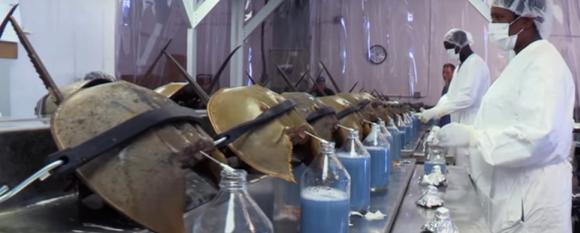 As the race is on to distribute Covid-19 vaccines around the globe, horseshoe crabs, or more specifically, horseshoe crab blood, is playing a major role in ensuring that the vaccines are safe to be injected into peoples’ arms. In fact, horseshoe crab blood plays an important role in the safety of all vaccines, but the surge in demand for Covid-19 vaccines is raising new concerns about potential overharvesting. Here is a repost updated for the pandemic from about a year and a half ago.
As the race is on to distribute Covid-19 vaccines around the globe, horseshoe crabs, or more specifically, horseshoe crab blood, is playing a major role in ensuring that the vaccines are safe to be injected into peoples’ arms. In fact, horseshoe crab blood plays an important role in the safety of all vaccines, but the surge in demand for Covid-19 vaccines is raising new concerns about potential overharvesting. Here is a repost updated for the pandemic from about a year and a half ago.
Horseshoe crabs are an ancient variety of arthropods, which are not actually crabs. Having remained largely unchanged in about 450 million years, the horseshoe crab is considered by many to be a living fossil. One of the reasons that horseshoe crabs have survived so long is that they have a highly robust immune system. Indeed, the horseshoe crab’s bright blue blood has remarkable antibacterial properties.
The good news for humans, and the bad news for horseshoe crabs, is that amebocytes in the horseshoe crab blood are highly sensitive to tiny amounts of bacteria and will coagulate around as little as one part in a trillion of bacterial contamination. Limulus Amebocyte Lysate, or LAL, a compound processed from horseshoe crab blood is used to test for contamination of anything that might go inside the human body: every shot, every IV drip, and every implanted medical device.
Bigthink.com reports that LAL has become nearly as valuable as gold. Thanks to the ubiquity of endotoxins and the dire need to test for their presence, a quart of horseshoe crab blood could fetch $15,000. Given that millions of human lives are probably saved yearly by horseshoe crab blood, the expense is well worth it. The question is, are we killing too many horseshoe crabs in the process.
So far, the consensus appears to be, no, although there is cause for concern. The latest survey in the Delaware Bay is that there are more than 14 million mature crabs.
Overfishing of horseshoe crabs has been a problem in the past when they were harvested for fertilizer. In the 1960s, the horseshoe crab population plummeted but began to rebound as the fertilizer industry switched to chemical fertilizers.
At roughly the same time, Dr. Frederik Bang, a Johns Hopkins researcher discovered the horseshoe crab blood’s remarkable ability to identify bacterial contamination.
Currently, pharmaceutical companies harvest as many as 600,000 horseshoe crabs a year. Like some sort of weird new-age vampires, Big Pharma drains up to 30% of the blood from the crabs before returning them to the ocean. Many do not survive the treatment. Estimates of survival rates vary wildly. Some official sources put the death rate at around 3 or 4%, but these figures typically represent only deaths directly resulting from transportation and handling. Other organizations put the mortality rate as high as 30%.
The really good news on the horizon is that the Big Pharma horseshoe crab vampires’ days may be numbered. Researchers in Singapore cloned the blood of horseshoe crabs and developed a synthetic test for endotoxins. In Europe last summer, authorities announced they will accept the synthetic test as equal to crab blood.
Wildlife groups and pharmaceutical companies expected the same decision from the U.S. Pharmacopeia, which sets the national standards for medicine. The approval didn’t come, though the U.S. Pharmacopeia left open the door for companies that want to use the synthetic and are willing to demonstrate that it’s safe and effective.
For now, the industry says it has plenty of horseshoe crab blood to screen coronavirus vaccines.
Thanks to Linda Collison for contributing to this post.

Thanks for investigating the topic. Very interesting.
“horseshoe crab blood are highly sensitive to ‘time’amounts of bacteria?
Did you mean tiny?
Thanks. Fixed it.